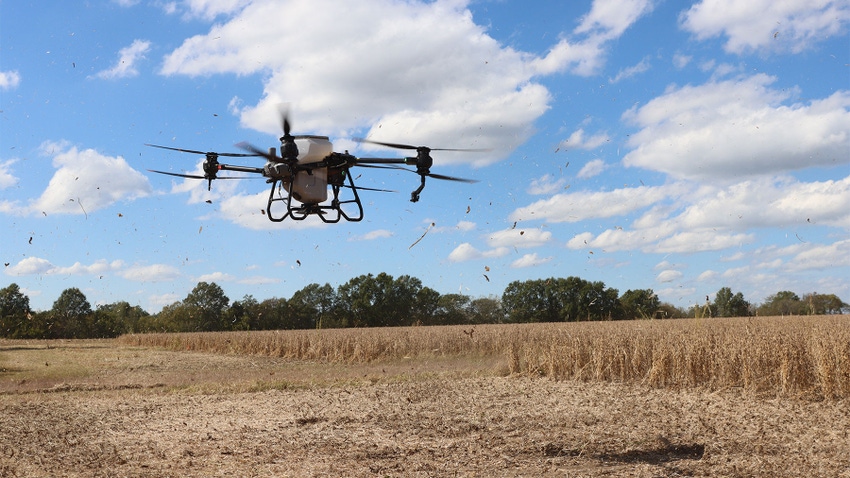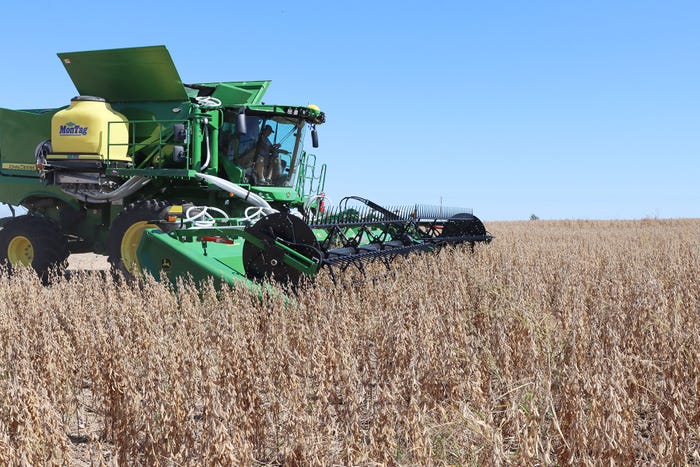
Farmers are excited and ready to plant cover crops, says Eric Oseland, director of agronomy and research at Missouri Soybeans. But the cost of the seed, fuel, equipment and labor turn some away from this soil health practice.
While Missouri Soybeans provides education on cost-share programs to offset input expenses, Oseland says labor is often a sticking point.
“There’s definitely a labor shortage in farming and agriculture,” he explains. “Not everybody has an extra set of hands to go out and get those cover crops planted.”
So, commodity groups, companies and universities are exploring new technologies to improve seeding efficiency of cover crops, including drones, modified seeding equipment and robotic seeders.
Determine drone capability
Last fall, Missouri Soybeans conducted research with the DJI T40 spreader and evaluated its effectiveness in terms of ground cover.
The University of Missouri, with funding from the Missouri Soybean Merchandising Council, conducted a drone application study with the DJI T40 spreader looking at seeding dynamics for large and small seeded cover crops.
The project compared the uniformity of establishment of cereal rye versus crimson clover, with a seeding rate of 100 pounds per acre, looking at the impact of flight altitude, spreader RPM and wind speed at application.
Oseland notes that while the seeding rate is extreme, it’s needed for adequate seed count in terms of distribution. Also, this study was not a cover crop mix, but rather separate single seed passes.
Here is the down and dirty on drones:
Calibration is required for accurate rates.
Wind speed has the biggest effect on small seed distribution.
Wind speed, plus direction, will affect all cover crop seed distribution.
Higher altitudes distribute seed in a wider swath.
Lower altitudes provide the best results with higher wind speeds.
Swath overlap will be needed for uniform distribution.
Using drones to seed cover crops is not simple, but Oseland contends it is a viable option for farmers.
Harvest seeding option
Missouri Soybeans also completed a study at its Bay Farm Research Facility, comparing different seeding methods for cereal rye — including a drone, modified equipment seeder and standard no-till box drill.
It provided Oseland with a first, in-the-field look at the Harvest Seeder from Red Barn Solutions, which uses the Montag 2108 air seeder fabricated for a John Deere S Series combine.

RESEARCH RESULTS: Missouri Soybeans put new cover crop seeding technologies such as the Harvest Seeder to the test last fall at Bay Farm Research Facility outside of Columbia, Mo. The results showed it provides similar coverage to a box drill without the extra pass across the field.
The design has a 50-cubic-foot seed capacity tank mounted on the side of the combine. Hoses run from the tank down to either a corn or soybean head. From there, distributors take the seed along the back side of the head where there is a shield.
While harvesting, the seed spits out, and that shield knocks it down to the ground, Oseland explains. “Ultimately, the idea is that the cash crop residue covers the seed up and gives it a seedbed as well,” he says.
The takeaways of the Harvest Seeder:
There are no extra fuel or labor costs.
It is simple to operate with the flip of a switch.
It offers one pass cover crop seeding.
Ground coverage is comparable to drill.
“It’s pretty slick technology,” Oseland adds. “You don’t have to wait until after harvest to apply cover crop seed. From that standpoint, it is efficient.”
Robots at work
One innovative technology Oseland stills wants to get a closer look at is a cover crop robotic seeder from the University of Illinois.
“Basically, you turn these things loose, and they plant cover crops while you’re on vacation,” he quips.
Missouri Soybeans would like to trial one on its Bay Farm Research Facility to evaluate its efficiency before recommending it as a viable cover crop seeding option for farmers.
“The scalability of those types of technologies is a challenge,” Oseland says, “but if they can get it figured out, it’s obviously something that’s pretty exciting on the horizon.”
About the Author(s)
You May Also Like






